7.10: Bacteria Classification
- Page ID
- 1460
\( \newcommand{\vecs}[1]{\overset { \scriptstyle \rightharpoonup} {\mathbf{#1}} } \)
\( \newcommand{\vecd}[1]{\overset{-\!-\!\rightharpoonup}{\vphantom{a}\smash {#1}}} \)
\( \newcommand{\dsum}{\displaystyle\sum\limits} \)
\( \newcommand{\dint}{\displaystyle\int\limits} \)
\( \newcommand{\dlim}{\displaystyle\lim\limits} \)
\( \newcommand{\id}{\mathrm{id}}\) \( \newcommand{\Span}{\mathrm{span}}\)
( \newcommand{\kernel}{\mathrm{null}\,}\) \( \newcommand{\range}{\mathrm{range}\,}\)
\( \newcommand{\RealPart}{\mathrm{Re}}\) \( \newcommand{\ImaginaryPart}{\mathrm{Im}}\)
\( \newcommand{\Argument}{\mathrm{Arg}}\) \( \newcommand{\norm}[1]{\| #1 \|}\)
\( \newcommand{\inner}[2]{\langle #1, #2 \rangle}\)
\( \newcommand{\Span}{\mathrm{span}}\)
\( \newcommand{\id}{\mathrm{id}}\)
\( \newcommand{\Span}{\mathrm{span}}\)
\( \newcommand{\kernel}{\mathrm{null}\,}\)
\( \newcommand{\range}{\mathrm{range}\,}\)
\( \newcommand{\RealPart}{\mathrm{Re}}\)
\( \newcommand{\ImaginaryPart}{\mathrm{Im}}\)
\( \newcommand{\Argument}{\mathrm{Arg}}\)
\( \newcommand{\norm}[1]{\| #1 \|}\)
\( \newcommand{\inner}[2]{\langle #1, #2 \rangle}\)
\( \newcommand{\Span}{\mathrm{span}}\) \( \newcommand{\AA}{\unicode[.8,0]{x212B}}\)
\( \newcommand{\vectorA}[1]{\vec{#1}} % arrow\)
\( \newcommand{\vectorAt}[1]{\vec{\text{#1}}} % arrow\)
\( \newcommand{\vectorB}[1]{\overset { \scriptstyle \rightharpoonup} {\mathbf{#1}} } \)
\( \newcommand{\vectorC}[1]{\textbf{#1}} \)
\( \newcommand{\vectorD}[1]{\overrightarrow{#1}} \)
\( \newcommand{\vectorDt}[1]{\overrightarrow{\text{#1}}} \)
\( \newcommand{\vectE}[1]{\overset{-\!-\!\rightharpoonup}{\vphantom{a}\smash{\mathbf {#1}}}} \)
\( \newcommand{\vecs}[1]{\overset { \scriptstyle \rightharpoonup} {\mathbf{#1}} } \)
\( \newcommand{\vecd}[1]{\overset{-\!-\!\rightharpoonup}{\vphantom{a}\smash {#1}}} \)
\(\newcommand{\avec}{\mathbf a}\) \(\newcommand{\bvec}{\mathbf b}\) \(\newcommand{\cvec}{\mathbf c}\) \(\newcommand{\dvec}{\mathbf d}\) \(\newcommand{\dtil}{\widetilde{\mathbf d}}\) \(\newcommand{\evec}{\mathbf e}\) \(\newcommand{\fvec}{\mathbf f}\) \(\newcommand{\nvec}{\mathbf n}\) \(\newcommand{\pvec}{\mathbf p}\) \(\newcommand{\qvec}{\mathbf q}\) \(\newcommand{\svec}{\mathbf s}\) \(\newcommand{\tvec}{\mathbf t}\) \(\newcommand{\uvec}{\mathbf u}\) \(\newcommand{\vvec}{\mathbf v}\) \(\newcommand{\wvec}{\mathbf w}\) \(\newcommand{\xvec}{\mathbf x}\) \(\newcommand{\yvec}{\mathbf y}\) \(\newcommand{\zvec}{\mathbf z}\) \(\newcommand{\rvec}{\mathbf r}\) \(\newcommand{\mvec}{\mathbf m}\) \(\newcommand{\zerovec}{\mathbf 0}\) \(\newcommand{\onevec}{\mathbf 1}\) \(\newcommand{\real}{\mathbb R}\) \(\newcommand{\twovec}[2]{\left[\begin{array}{r}#1 \\ #2 \end{array}\right]}\) \(\newcommand{\ctwovec}[2]{\left[\begin{array}{c}#1 \\ #2 \end{array}\right]}\) \(\newcommand{\threevec}[3]{\left[\begin{array}{r}#1 \\ #2 \\ #3 \end{array}\right]}\) \(\newcommand{\cthreevec}[3]{\left[\begin{array}{c}#1 \\ #2 \\ #3 \end{array}\right]}\) \(\newcommand{\fourvec}[4]{\left[\begin{array}{r}#1 \\ #2 \\ #3 \\ #4 \end{array}\right]}\) \(\newcommand{\cfourvec}[4]{\left[\begin{array}{c}#1 \\ #2 \\ #3 \\ #4 \end{array}\right]}\) \(\newcommand{\fivevec}[5]{\left[\begin{array}{r}#1 \\ #2 \\ #3 \\ #4 \\ #5 \\ \end{array}\right]}\) \(\newcommand{\cfivevec}[5]{\left[\begin{array}{c}#1 \\ #2 \\ #3 \\ #4 \\ #5 \\ \end{array}\right]}\) \(\newcommand{\mattwo}[4]{\left[\begin{array}{rr}#1 \amp #2 \\ #3 \amp #4 \\ \end{array}\right]}\) \(\newcommand{\laspan}[1]{\text{Span}\{#1\}}\) \(\newcommand{\bcal}{\cal B}\) \(\newcommand{\ccal}{\cal C}\) \(\newcommand{\scal}{\cal S}\) \(\newcommand{\wcal}{\cal W}\) \(\newcommand{\ecal}{\cal E}\) \(\newcommand{\coords}[2]{\left\{#1\right\}_{#2}}\) \(\newcommand{\gray}[1]{\color{gray}{#1}}\) \(\newcommand{\lgray}[1]{\color{lightgray}{#1}}\) \(\newcommand{\rank}{\operatorname{rank}}\) \(\newcommand{\row}{\text{Row}}\) \(\newcommand{\col}{\text{Col}}\) \(\renewcommand{\row}{\text{Row}}\) \(\newcommand{\nul}{\text{Nul}}\) \(\newcommand{\var}{\text{Var}}\) \(\newcommand{\corr}{\text{corr}}\) \(\newcommand{\len}[1]{\left|#1\right|}\) \(\newcommand{\bbar}{\overline{\bvec}}\) \(\newcommand{\bhat}{\widehat{\bvec}}\) \(\newcommand{\bperp}{\bvec^\perp}\) \(\newcommand{\xhat}{\widehat{\xvec}}\) \(\newcommand{\vhat}{\widehat{\vvec}}\) \(\newcommand{\uhat}{\widehat{\uvec}}\) \(\newcommand{\what}{\widehat{\wvec}}\) \(\newcommand{\Sighat}{\widehat{\Sigma}}\) \(\newcommand{\lt}{<}\) \(\newcommand{\gt}{>}\) \(\newcommand{\amp}{&}\) \(\definecolor{fillinmathshade}{gray}{0.9}\)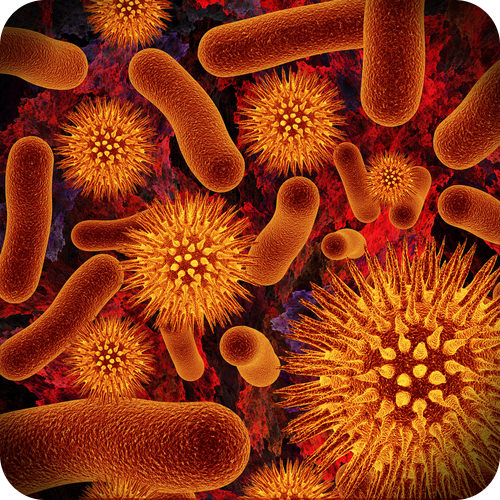
With so many different bacteria, how are they all classified?
By shape? By size? By some other criteria? As you can imagine, classifying bacteria is probably not an easy task. Bacteria are classified by their traits, some of which have to do with their shape, others with the cell wall, and even additional traits.
The Prokaryotic Domains
Domain Bacteria
Bacteria are the most diverse and abundant group of organisms on Earth. They live in almost all environments. They are found in the ocean, the soil, and the intestines of animals. They are even found in rocks deep below Earth’s surface. Any surface that has not been sterilized is likely to be covered with bacteria. The total number of bacteria in the world is amazing. It’s estimated to be 5 × 1030, or five million trillion. You have more bacteria in and on your body than you have body cells!
Bacteria called cyanobacteria are very important. They are bluish green in color (see Figure below) because they contain chlorophyll (but not chloroplasts, of course). They make food through photosynthesis and release oxygen into the air. These bacteria were probably responsible for adding oxygen to the air on early Earth. This changed the planet’s atmosphere. It also changed the direction of evolution. Ancient cyanobacteria also may have evolved into the chloroplasts of plant cells.
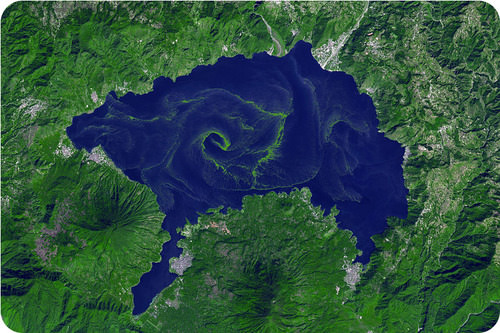
Thousands of species of bacteria have been discovered, and many more are thought to exist. The known species can be classified on the basis of various traits. One classification is based on differences in their cell walls and outer membranes. It groups bacteria into Gram-positive and Gram-negative bacteria, as described in Figure below.
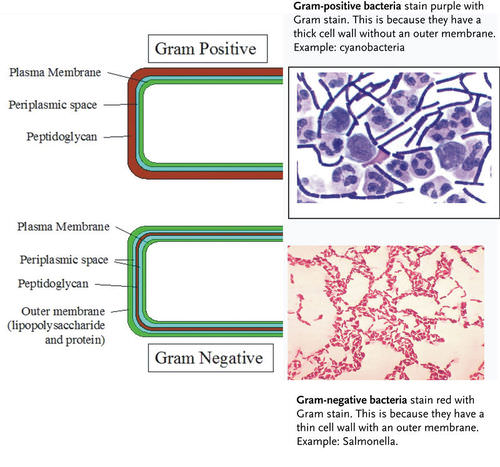 Classification of Bacteria. Different types of bacteria stain a different color when stained with Gram stain. This makes them easy to identify.
Classification of Bacteria. Different types of bacteria stain a different color when stained with Gram stain. This makes them easy to identify.Domain Archaea
Scientists still know relatively little about Archaea. This is partly because they are hard to grow in the lab. Many live inside the bodies of animals, including humans. However, none are known for certain to cause disease.
Archaea were first discovered in extreme environments. For example, some were found in hot springs. Others were found around deep sea vents. Such Archaea are called extremophiles, or “lovers of extremes.” Figure below describes three different types of Archaean extremophiles. The places where some of them live are thought to be similar to the environment on ancient Earth. This suggests that they may have evolved very early in Earth’s history.
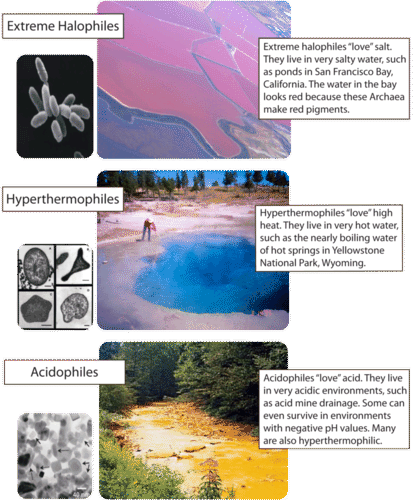 Extremophile Archaea. Many Archaea are specialized to live in extreme environments. Just three types are described here.
Extremophile Archaea. Many Archaea are specialized to live in extreme environments. Just three types are described here.Archaea are now known to live just about everywhere on Earth. They are particularly numerous in the ocean. Archaea in plankton may be one of the most abundant types of organisms on the planet. Archaea are also thought to play important roles in the carbon and nitrogen cycles. For these reasons, Archaea are now recognized as a major aspect of life on Earth.
Science Friday: Subvisual Subway: The Art of New York City's Bacterial World
An urban legend states that "using the handrails on the subway is like shaking hands with 100 people." In this video by Science Friday, Craig Ward sampled the bacteria on subway lines around New York City to create striking and unconventional "portraits" of NYC commuters.
Science Friday: Dawn of the Cyborg Bacteria
Does using bacteria to power microscopic robots sound like a horror film? In this video by Science Friday, Ph.D. students Elizabeth Beattie and Denise Wong hope these nano bio-robots will provide a platform for future medical and micro-engineering endeavors.
Summary
- Bacteria live in virtually all environments on Earth.
- Archaea live everywhere on Earth, including extreme environments.
Review
- Distinguish between Gram-positive and Gram-negative bacteria, and give an example of each.
- Summarize the evolutionary significance of cyanobacteria.
- What are extremophiles? Name three types.
- Describe the habitat of extreme halophiles.
| Image | Reference | Attributions |
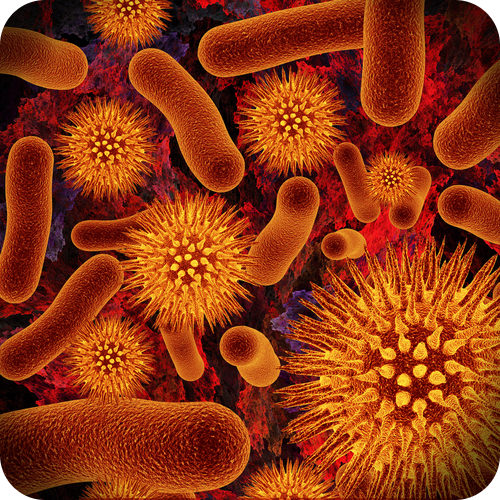 |
[Figure 1] | License: CC BY-NC |
 |
[Figure 2] | Credit: Courtesy of Jesse Allen/NASA Source: commons.wikimedia.org/wiki/File:Harmful_Bloom_in_Lake_Atitl%C3%A1n ; _Guatemala.jpg License: Public Domain |
 |
[Figure 3] | Credit: Gram cell wall: User:JulianOnions/Wikimedia Commons; Gram-positive: JA Jernigan et al./Centers for Disease Control and Prevention; Gram-negative: William A. Clark/Centers for Disease and Control Source: Gram cell wall: commons.wikimedia.org/wiki/File:Gram-Cell-Wall.jpg ; Gram-positive: http://www.cdc.gov/ncidod/EID/vol7no6/jerniganG2.htm ; Gram-negative: commons.wikimedia.org/wiki/File:Bacillus_coagulans_01.jpg License: Public Domain |
 |
[Figure 4] | Credit: From left to right, top to bottom: NASA; Tom Hilton; PMEL/National Oceanic and Atmospheric Administration; US Geological Survey; NASA; Environmental Protection Agency Source: From left to right ; top to bottom: http://science.nasa.gov/science-news/science-at-nasa/2004/10sep_radmicrobe/ ; http://www.flickr.com/photos/tomhilton/4689387475/ ; http://www.pmel.noaa.gov/vents/nemo1999/images/bugtem.gif ; http://wwwbrr.cr.usgs.gov/projects/GWC_chemtherm/ ; astrobiology.nasa.gov/articles/is-there-life-on-mars-ask-a-magnet/ ; http://water.epa.gov/polwaste/nps/acid_mne.cfm License: From left to right, top to bottom: Public Domain; CC BY 2.0; Public Domain; Public Domain; Public Domain; Public Domain |

